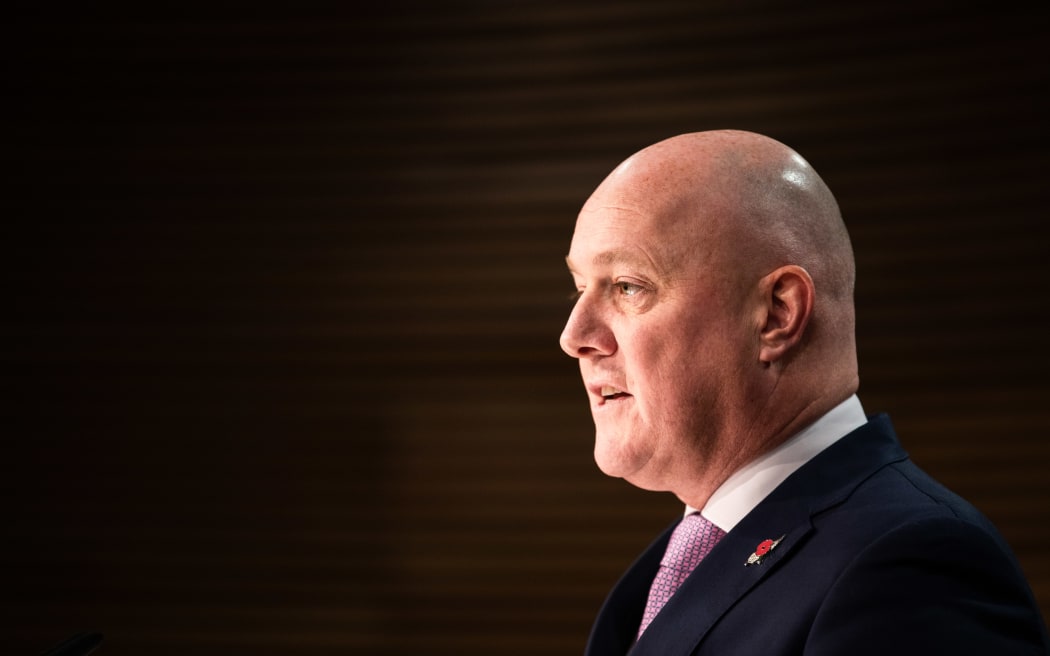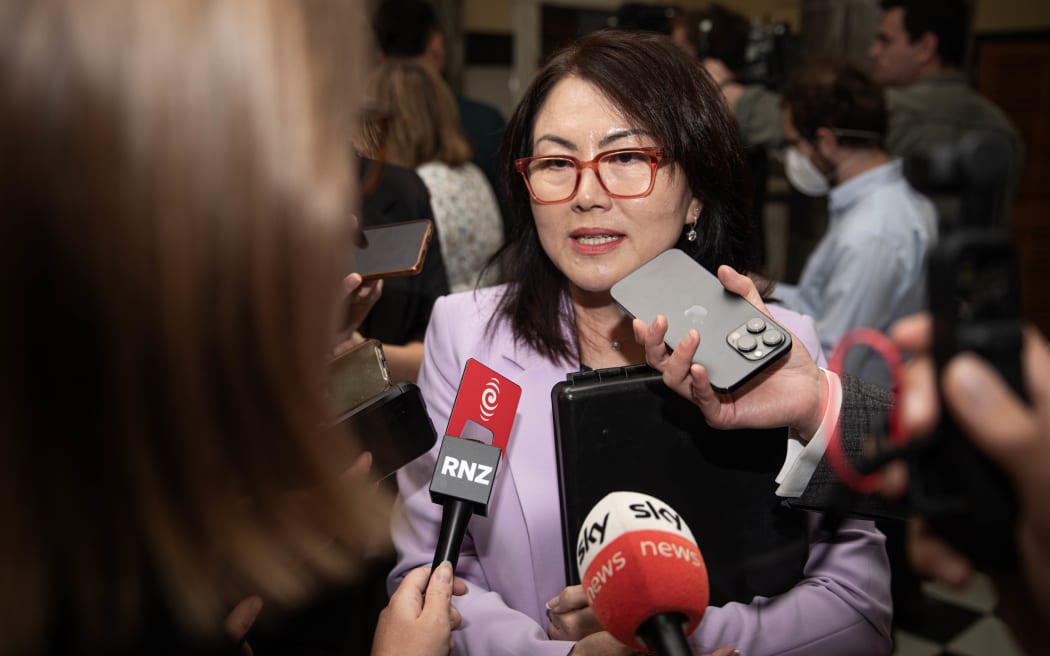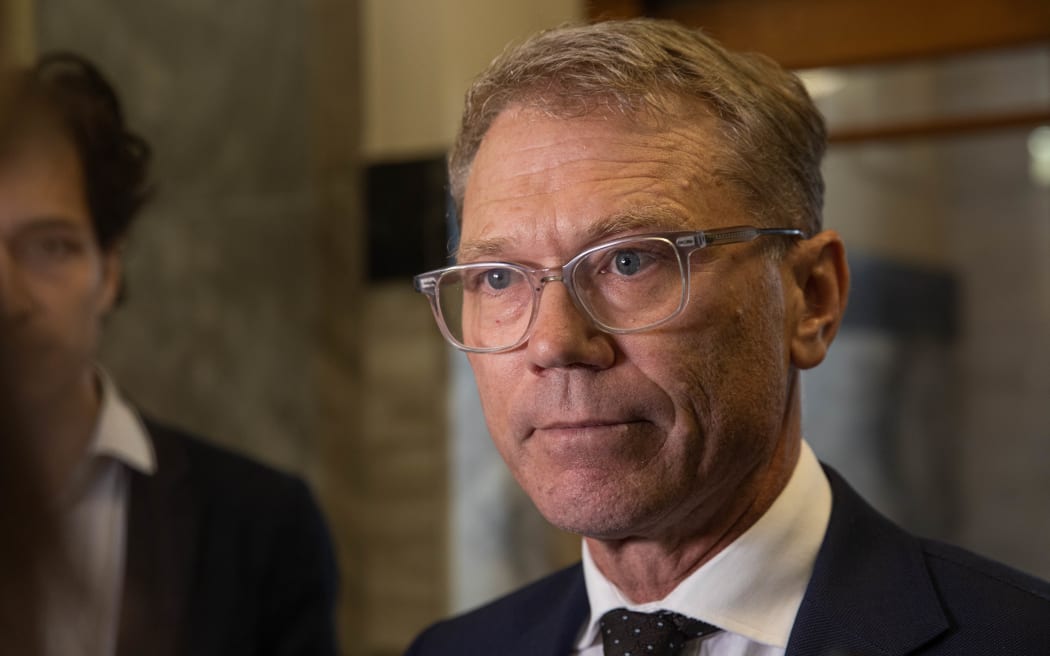
Photo: RNZ / Samuel Rillstone
Melissa Lee has been replaced as Minister of Media and Communications after just seven months in the role in which she promised new policy to address the media’s acute problems.
Paul Goldsmith now inherits the tricky job some predecessors have cited as a reason for resigning - or even quitting politics altogether.
It has proved to be a difficult and not exactly career-enhancing job.
Having heralded a new era for broadcasting, Clare Curran became the first minister to go in the new Labour-led government in September 2018 after a string of problems - and little progress on bold plans for reform of broadcasting funding and regulation and the introduction of an ‘RNZ with Pictures’ service called RNZ+.
When she left Parliament in 2020, she cited relentless and amplified criticism as one reason, and she later revealed she needed counseling to recover.
Her successor Kris Faafoi took over for a turbulent period, overseeing Covid-era media industry relief and introducing the Public Interest Journalism Fund.
But before he quit in June 2022 to spend more time with his family (and fire up a lobbying business), he approved RNZ’s ill-fated youth network idea (aka the RNZ Concert fiasco) and set in train the RNZ/TVNZ merger which was subsequently scrapped at the last minute.
The portfolio also gave his successor Willie Jackson headaches in the 15 months until Labour’s 2023 election defeat.
A constant thorn in the side of all three ministers was Melissa Lee, the opposition spokesperson throughout Labour’s time in charge.

Photo: RNZ / Angus Dreaver
Oppositional behaviour
It was Lee’s dogged questioning of a hesitant Curran in Parliament that prompted her decision to resign.
Lee also persistently highlighted flaws (potential and actual) in the government’s media plans in media releases and awkward written questions to ministers.
At the Parliamentary select committees conducting annual reviews of state-owned RNZ and TVNZ, Lee raised ‘cancel culture” and asked if increased government funding would also mean potential influence brought to bear on editorial matters.
She campaigned hard against the Labour government plan to create and fund a not-for-profit public media entity to replace non-commercial RNZ and highly-commercial TVNZ.
She said it was “a solution looking for a problem” that would reduce media plurality.
Her party seized on that as a prime example of wasteful government spending as the election drew near.
She made a point of emphasising her own pre-politics media career producing and presented the NZ on Air-funded Asia Downunder show.
But the National Party went into that election without a proper media policy of its own, and Lee - and the government - were exposed when the finances of the news media slumped from late 2023.
Into the red
TVNZ had insisted during the media process that its revenue-raising powers were still strong, but just before the election it announced an ominous round of belt-tightening.
In late February, TVNZ announced its revenue had slumped significantly in the back half of last year.
In early March, just three days after Newshub’s owners announced its complete closure for financial reasons, TVNZ announced big cuts to its news and current affairs shows.
Lee admitted in live radio interviews at the time she did not know cuts to news programmes were coming even though she had recently met executives of both broadcasters.
In pointing out - correctly - that she had limited scope to influence operational matters at commercial broadcasters, Lee was accused of a “tone deaf” lack of empathy.
“I’m not a magician,” she told reporters, adding that she was “personally happy with the current plurality” of local media.
Her fellow TVNZ shareholding minister David Seymour was even less warm. He even took the opportunity to single out TVNZ’s political reporting of himself.
This pointed to difficulties to come with the government’s other key coalition partner, NZ First’s Winston Peters - also a frequent and strident critic of the media who even hinted at taking the broadcasting portfolio himself to sort out “corrupt” TVNZ in a now-notorious election-period interview.
After the PM told media last month Lee would bring to Cabinet proposals to help the media sector, Newsroom reported that Lee made “a rookie mistake” by not running them past Peters first.
That would mean no progress on her plans until Peters returns to New Zealand at the end of this month.
What were her plans anyway?
Good question - and one the media never got a clear answer to.
She did tell media broadcasting legislation was out of date, picking out the Broadcasting Act of 1989.
But it was not clear how reform of that could help struggling commercial media companies.
The Fair Digital News Bargaining Bill introduced by Labour could help by pressuring Meta and Google to pay for local news of their services.
But that Bill was not one of the many the government wanted to progress under urgency in its first 100 days. And there was nothing media-relevant in the government’s recently-released action plan for the coming quarter.
Journalists asking for more detail were on a hiding to nothing. Lee cancelled interviews with Mediawatch and the New Zealand Herald, claiming they would be boring because she would have little to say about her plans. ‘
When doorstepped by political reporters at Parliament, Lee would only barely acknowledge the existence of any plans while at the same time insisting she was working hard on them.
It prompted Spinoff editor Toby Manhire to ponder whether some sort of super-injunction was in play, precluding any mention of the story, let alone any denials or details.
Just 10 days ago, Prime Minister Christopher Luxon backed Lee. He was not planning on taking her portfolios off her "at this point", he said before reasserting his confidence in her.
Subsequent interviews to fill the news void did not go well.
Newstalk ZB’s Heather Du Plessis-Allan accused her of being “shady and weird” while ZB’s Mike Hosking told her bluntly her plans were “doomed” whatever they may be.
The Herald’s Media Insider wondered - presciently - whether she would still be the minister when Cabinet finally considered the under-wraps plan.

Photo: RNZ / Angus Dreaver
That’s how he rolls
Today the PM told reporters the media situation has become more complex, calling for a “senior minister with adjacent responsibilities".
“That’s how I roll,” he said, demoting Lee and Disability Issues minister Penny Simmonds at the same time.
“Enjoy your AGM,” the PM signed off, having apologised for delaying the Press Gallery’s scheduled annual meeting.
He had just given them another item for their agenda: a brand new minister to push forward an as-yet-unknown plan to ease the media’s financial plight: Paul Goldsmith.
As Arts, Culture and Heritage Minister, Goldsmith was responsible for the government broadcasting funding agency NZ on Air.
Last week he told the Herald’s Media Insider in a statement that he and Lee were “working to understand the challenges and opportunities facing the screen sector”.
What could be on the table - and in the Cabinet paper
Aside from the Fair Digital News Bargaining Bill, still before Parliament, the government could give broadcasters a break on the $40 million annual cost of transmission fees payable to state-owned company Kordia.
The Herald reported on Tuesday the issue was discussed when the former minister met broadcasters two weeks ago.
The PM and former minister has repeatedly said bailouts or further subsidies for commercial media will not be considered, but the idea of some form of levy on online advertising or digital transactions to fund media could be considered.
He will face a similar challenge to his predecessors - pressing concerns in other portfolios deemed more important than broadcasting and media.
He was also minister of justice, state owned enterprises, Treaty of Waitangi negotiations as well as arts, culture and heritage.


